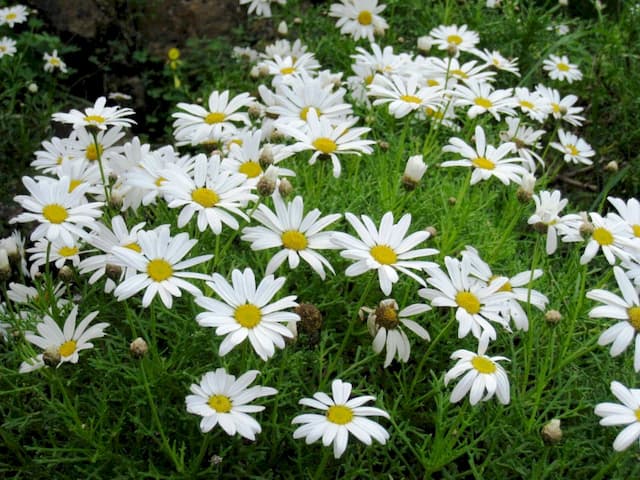Milk thistle Silybum marianum

ABOUT
Commonly known as milk thistle, this distinctive plant is easily recognizable due to its glossy, green leaves that feature white mottling or veins, creating a marbled appearance. The leaves are large, lobed, and often have spiny edges, which can be quite sharp. Milk thistle is renowned for its robust purple to red flowers that are thistle-like in structure and form at the top of the stems, usually surrounded by a spiky bract that protects it. The flowers are globe-shaped and can be quite prominent, adding to the visual interest of the plant. Once the flowering is complete, it produces a hard fruit with a tuft of hair, which assists in its dispersal by wind.
About this plant
 Names
NamesFamily
Asteraceae.
Synonyms
Milk Thistle, Blessed Milkthistle, Marian Thistle, Mary Thistle, Saint Mary's Thistle, Mediterranean Milk Thistle, Variegated Thistle, Scotch Thistle.
Common names
Carduus marianus, Silybum pygmaeum, Centaurea dalmatica, Mariana lactea, Silybum maculatum, Carduus lacteus, Carduus mariae, Carduus marianus var. hispanicus, Silybum marianum subsp. marianum, Silybum marianum var. hispanicum.
 Toxicity
ToxicityTo humans
Milk thistle, the common name for Silybum marianum, is not generally considered toxic to humans. Traditionally, various parts of milk thistle, especially the seeds, have been used for their therapeutic properties, particularly for liver-related disorders. However, like any substance, it can cause undesirable effects if taken inappropriately. Mild gastrointestinal distress, such as diarrhea, bloating, or an upset stomach, may occur with its use. It may also cause allergic reactions in people who are sensitive to the Asteraceae/Compositae family of plants. There is not a significant concern regarding acute toxicity from ingesting the plant in typical amounts.
To pets
Milk thistle is not commonly recognized as a toxic plant to pets; in fact, it is often used in veterinary medicine for its beneficial effects on the liver and its antioxidant properties. There isn't a well-documented toxicity level for pets. Just like in humans, if a pet ingests an unusually large amount of milk thistle, it could potentially cause mild digestive upset. If pets have a pre-existing allergy to plants in the Asteraceae/Compositae family, they could potentially show allergic reactions. However, milk thistle is generally considered safe for pets when used appropriately under veterinary guidance.
 Characteristics
CharacteristicsLife cycle
Biennials
Foliage type
Deciduous
Color of leaves
Variegated
Flower color
Purple
Height
3-4 feet (0.9-1.2 meters)
Spread
2-3 feet (0.6-0.9 meters)
Plant type
Herb
Hardiness zones
7
Native area
Mediterranean
Benefits
 General Benefits
General Benefits- Supports liver health - The active compounds in Milk thistle, particularly silymarin, have been shown to support liver function and help in the regeneration of liver tissue.
- Antioxidant properties - Milk thistle is rich in antioxidants, which help protect the body from oxidative stress and may contribute to overall health.
- Improves digestive function - It is known to promote bile production and flow, which aids in digestion and the breakdown of dietary fats.
- Supports skin health - The antioxidant and anti-inflammatory properties of Milk thistle may be beneficial for maintaining healthy skin and managing certain skin conditions.
- Gallbladder support - Milk thistle may aid in the prevention of gallstone formation and support gallbladder health due to its effects on bile production.
- May help control blood sugar levels - Some research suggests that Milk thistle may help in managing blood sugar levels, although this is closely tied to its potential medical uses.
 Medical Properties
Medical Properties- Hepatoprotective: Silybum marianum, commonly known as milk thistle, contains silymarin, a complex of flavonolignans that has been reported to have protective effects on the liver.
- Antioxidant: Milk thistle is known for its antioxidant properties, which can help to protect cells from free radical damage.
- Anti-inflammatory: The plant has been suggested to have anti-inflammatory effects, which may be beneficial in reducing inflammation in the body.
- Antifibrotic: Silymarin from milk thistle may reduce the progression of fibrosis in the liver, which can be a result of chronic liver diseases.
- Choleretic: Milk thistle is believed to increase bile production and flow, which can be helpful for liver and gallbladder function.
- Glucose Metabolism: Some evidence suggests that milk thistle may help in regulating glucose levels, although more research is needed in this area.
- Neuroprotective: There is some preliminary evidence that suggests that milk thistle may have protective effects on the brain and nervous system.
 Air-purifying Qualities
Air-purifying QualitiesThis plant is not specifically known for air purifying qualities.
 Other Uses
Other Uses- Silybum marianum, commonly known as milk thistle, has traditionally been used to produce a natural rennet alternative for cheese-making, utilizing the flower part of the plant that contains coagulating properties.
- The leaves of milk thistle can be used in salads or as a cooked green, similar to spinach, by removing the spines and preparing them with a light sauté or steam.
- Milk thistle seeds are sometimes roasted and used as a coffee substitute or additive, providing a unique flavor akin to the coffee experience but without the caffeine.
- In some cultures, milk thistle is used as a vegetable in its own right; the stalks, roots, and flowers can be consumed after appropriate preparation to remove bitterness and spikiness.
- The plant's fluff, the fine hairs from the flower head, can be gathered and utilized as tinder for starting fires, due to its easy ignition properties.
- Milk thistle's decorative flowers are used in floral arrangements both as fresh and dried flowers, adding an exotic and wild aesthetic to bouquets and decorations.
- The fibrous parts of milk thistle have been used in traditional crafting for making natural twine or rope, though this is not as common with the advent of modern materials.
- Milk thistle seed oil can be extracted and used as a natural varnish for wood, providing a protective and non-toxic coating for wooden utensils and furniture.
- The dried flowering heads of milk thistle can be used in the making of natural dyes, offering a range of colors from green to brown, depending on the mordant used.
- Due to its striking appearance, milk thistle is planted as an ornamental plant in gardens for its ability to attract pollinators like bees and butterflies, while also acting as a natural pest deterrent for certain garden pests.
Interesting Facts
 Feng Shui
Feng ShuiThe Milk Thistle is not used in Feng Shui practice.
 Zodiac Sign Compitability
Zodiac Sign CompitabilityThe Milk Thistle is not used in astrology practice.
 Plant Symbolism
Plant Symbolism- Protection: Silybum marianum, commonly known as Milk Thistle, is often associated with protection due to its prickly outer layer and tightly closed buds, representing a natural barrier against harm.
- Healing: With its medicinal properties, Milk Thistle symbolizes healing, particularly for liver ailments, signifying regeneration and recovery.
- Strength: The vigorous nature of Milk Thistle, with its ability to grow in less-than-ideal conditions, symbolizes resilience and the ability to endure and overcome adversity.
- Detoxification: Milk Thistle is commonly tied to the concept of detoxification, mirroring its use in herbal medicine to cleanse and rejuvenate the body, especially after exposure to toxins or substance abuse.
 Water
WaterFor the Milk Thistle, it's crucial to maintain a balance as they are somewhat drought tolerant but also need consistent moisture, especially during the growing season. Watering thoroughly once a week with about 1-2 inches of water should suffice, but always check the soil before watering; it should be dry down to about an inch deep. During particularly hot and dry periods, you may need to water more frequently. Always avoid overhead watering to prevent mildew and other fungal issues, and instead use a soaker hose or water directly at the base of the plant.
 Light
LightThe Milk Thistle prefers full sun to thrive, ideally receiving at least 6 hours of direct sunlight daily. Planting Milk Thistle in a spot where it can enjoy uninterrupted sunlight will support the best growth and flowering. However, it can tolerate partial shade, especially in regions with very intense sun.
 Temperature
TemperatureMilk Thistle grows best in temperatures ranging from 50 to 80 degrees Fahrenheit, but it can survive in temperatures as low as 20 degrees and as high as 90 degrees Fahrenheit for brief periods. The ideal growth temperatures are moderate, so they should not be subjected to prolonged extreme heat or frost conditions.
 Pruning
PruningPrune Milk Thistle to remove spent flowers and to prevent self-seeding if you want to avoid it becoming invasive. Pruning can be done throughout the growing season as needed, but the best time is after the plant has flowered and the heads have browned. Cutting back the entire plant in late fall or early winter will also encourage a tidier appearance.
 Cleaning
CleaningAs needed
 Soil
SoilMilk thistle requires well-draining soil with a slightly acidic to neutral pH range of 6.0 to 7.0. A mix of loam, sand, and compost is ideal to ensure good drainage and adequate nutrients. Adjust soil pH if necessary using lime to raise it or sulfur to lower it to match these conditions.
 Repotting
RepottingMilk thistle typically does not need frequent repotting as it is a biennial plant and completes its life cycle in two years. Repot only if it outgrows its container or the soil becomes depleted.
 Humidity & Misting
Humidity & MistingMilk thistle is tolerant of a wide range of humidity levels and does not require special humidity conditions. It can thrive in the average humidity levels found in most outdoor environments.
 Suitable locations
Suitable locationsIndoor
Place milk thistle in a sunny spot; water when the soil is dry.
Outdoor
Plant in sunny area, water moderately, protect from extreme cold.
Hardiness zone
7-9 USDA
 Life cycle
Life cycleSilybum marianum, commonly known as milk thistle, begins its life cycle with seed germination, which typically occurs in late winter or early spring when soil temperatures are suitable. The plant develops a rosette of spiny leaves with distinctive white veins in its first year of growth. In its second year, milk thistle produces a tall, branched stem that can reach up to 2 meters in height, with the rosette leaves at the base enlarging and thickening. From mid to late summer, purple to red flower heads bloom, which are surrounded by a spiny involucre. After pollination, often by bees, the plant produces glossy brown seeds with a tuft of hair, which facilitate wind dispersal. The plant then completes its life cycle by dying, with the seeds remaining dormant until the next appropriate growing season.
 Propogation
PropogationPropogation time
Spring to early summer
Propogation: The most popular method of propagating Silybum marianum, commonly known as milk thistle, is through its seeds. Propagation time is typically in the spring after the last frost when soil temperatures are above 50 degrees Fahrenheit (10 degrees Celsius). The seeds are sown directly into well-drained soil, at a depth of about a quarter inch (6 millimeters). They should be spaced out by at least 12 inches (30 centimeters) to accommodate the mature size of the plant. Germination usually occurs within two to three weeks. Once the seedlings have established themselves and produced a set of true leaves, thinning may be necessary to prevent overcrowding. It's important to keep the soil moist but not waterlogged to ensure healthy growth.





![Marigold [PowerDaisy Tango]](/_next/image?url=https%3A%2F%2Fplants-admin.emdemapps.com%2Fimages%2Fplants%2F%2Fimages%2F604b567a0b366.png&w=640&q=75)



